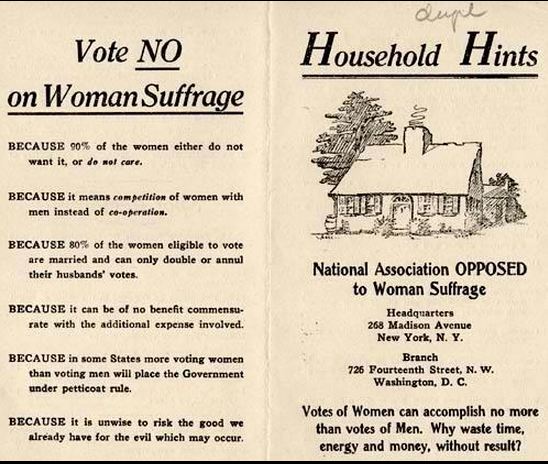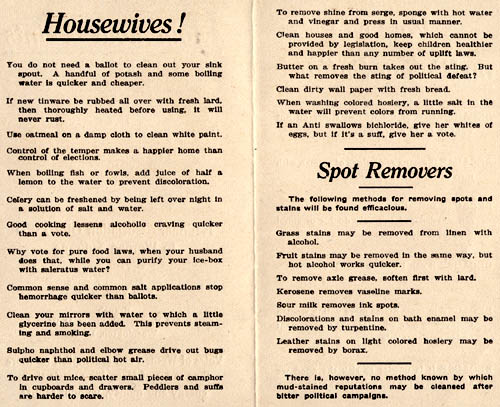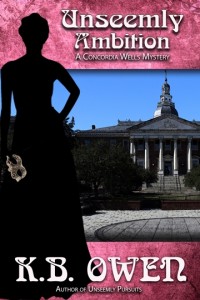With election day coming up in the United States, my thoughts are turning to a woman’s right to vote. We are so accustomed to any U.S. citizen being allowed to cast a ballot that it’s difficult to conceive of parts of the world where that still isn’t the case. There’s an interesting story from last year’s post about how the amendment was finally ratified, if you’d like to check it out: a woman’s right to vote.
The suffragists sacrificed a great deal in order to agitate for change. It was a long, hard road that began with the Seneca Falls Women’s Rights Convention of 1848 and continued on until the 19th Amendment was ratified in 1920. If you’re curious about the Seneca Falls Convention, click here for my page on the subject.

Much of society, including women, resisted the idea of female suffrage. People made all sorts of dire predictions if women got the vote: “petticoat rule” would ensue; women would leave their children and their kitchens to meddle in men’s affairs; women would then make “unreasonable” demands for rights in other areas of their lives.
Just to give you an idea of the attitudes the suffragists were up against, here are two pictures from a widely-circulated handbook on “Household Tips” (date unknown, probably 1914-19):
Here’s the inside of the pamphlet:
What a zinger: “You do not need a ballot to clean out your sink spout. A handful of potash and some boiling water is quicker and cheaper.” Wow.
The women’s suffrage movement gained ground during World War I, and activists suffered greatly for their cause during this time. They were mocked and spat upon as they marched; they were arrested and jailed; they were beaten and force-fed through the nose when they went on hunger strikes in prison.
One night, in 1917, Lucy Burns (an oft-arrested activist) and her fellow activists endured what has been termed the “Night of Terror” in the Occoquan Workhouse in Virginia. They were beaten by the guards who then withheld any medical attention for their injuries. To keep their spirits up, Lucy conducted a roll call of her fellow women suffragists and would not stop, despite the guards’ threats. They handcuffed her hands above her head to the cell door and left her that way all night. I’ve not been able to confirm it with additional sources, but one version of the story goes that her fellow activists showed their solidarity with Lucy by assuming the same posture and enduring it along with her in their separate cells. On another occasion, Lucy went on a hunger strike and was force-fed so violently that she had severe nosebleeds.

What the suffragists endured became widely known after their release, and the public outrage over women being treated so harshly for peaceably conducting marches and holding signs helped to fuel their cause. The experiences took their toll on Lucy Burns, who retired from public life as soon as the amendment was passed.
!["Lucy Burns in Occoquan Workhouse" by Photographs from the Records of the National Woman's Party / Harris & Ewing, Washington, D.C. - Library of Congress / [1]. Licensed under Public domain via Wikimedia Commons - http://commons.wikimedia.org/wiki/File:Lucy_Burns_in_Occoquan_Workhouse.jpg#mediaviewer/File:Lucy_Burns_in_Occoquan_Workhouse.jpg](https://kbowenmysteries.com/wp-content/uploads/2014/10/Lucy_Burns_in_Occoquan_Workhouse-177x300.jpg)

Want more information about the Occoquan Workhouse?
From the White House to the Workhouse to the Franchise
Photos from the Women’s Suffrage Movement (slideshow)
General info on the suffrage movement:
What piece of history moves you and influences your life? I’d love to hear from you.
Until next time,
Kathy
P.S. – My Unseemly Ambition giveaway is in full swing! Click here for the list of prizes and how to get your name in the drawing (multiple times!).






Isn’t if funny how backward it all seems now? I mean – holy cow – really? Some of that “information” in the pamphlet is just – wow!
Good for us women for keeping at it. Girls rule!!
Patricia Rickrode
w/a Jansen Schmidt
Absolutely, Patricia! That’s the cool thing about history – seeing how far we’ve come. 😉
Iron Jawed Angels is a powerful film on the subject.
I ran across that in my research, but haven’t had a chance to see it. Thanks so much for the contribution, Yves!
OMG! I was geared up to make snarky comments about not-so-subliminal propaganda hidden in those household tips. Seriously? “Good cooking lessens alcoholic craving faster than a vote.”
Then, I moved on and read the abuse the suffragists endured that gave me the right to cast my vote. Frankly, I had no clue. I thought they marched and were mocked. This shameful bit of American history was glossed over in my history classes.
WOWZA! A worthy use for a brain cell memory chip. Much better than the use of fresh bread to clean wallpaper, or cure alcoholism with a well cooked meal.
Thanks, K.B.
ASIDE: What’s wrong with canceling out a husband’s vote? I do it all the time at home. “I’d agree with you, but then we’d both be wrong.” <=== One of the snarky wall pieces I'm collecting for our half bath. I'm debating whether or not I can get away with "Anyone looking for a husband has obviously never had one."
Gloria, your bathroom sounds like an interesting place! And it’s amazing what gets left out of history books. Feel free to snark any time. 😉
My word!! That pamphlet is a disgrace! I cannot imagine any American woman at the time taking that nugget lightly. Thanks for putting this post together–I loved it!
Thanks, Jill! Love that not-so-subtle anti-suffrage message in the “Household Hints.”
It’s heartbreaking to consider what the suffragists went through, and beautiful and admirable at the same time. We’re so fortunate that they fought for our right. Thanks for this post!
We really are fortunate to have such tenacious women! Thanks so much for stopping by, August.
Honestly, the first spark of my interest in history was my 8th grade class. My teacher talked about how her grandmother was a suffragist and the lengths she went to, just to make sure girl like me could vote someday. That made a big impression on me. (And I went on to get my bachelor’s degree in history.)
Thankfully, I’ve always been raised to believe that my political opinions were as important as a man’s. And my vote doesn’t double or annul my husband’s vote; we are one in our marriage but as distinct as any voters in an election. (That one made me roll my eyes.) Thanks for such a great post, Kathy!
It always makes a world of difference when the history has a personal connection. How cool to have a teacher with a connection like that! Thanks, Julie. 🙂
Thankfully women in New Zealand got the vote in 1893 – beat you to it 🙂
I don’t think Kiwi “suffs” ever endured the degree of ill-treatment their comrades in the UK & US did, but they certainly endured “a whole lot of ugly coming from a never-ending parade of stupid”!
I don’t know about the States, but in NZ the spearhead of the movement was the Women’s Christian Temperance Union – their leader Kate Sheppard is featured on our ten-dollar note.
Deborah, you guys are definitely ahead of the UK and US! And your quote is very apt, LOL. 😉 Nice to see that your currency reflects the importance of the pioneers of NZ women’s rights. So glad you stopped by!